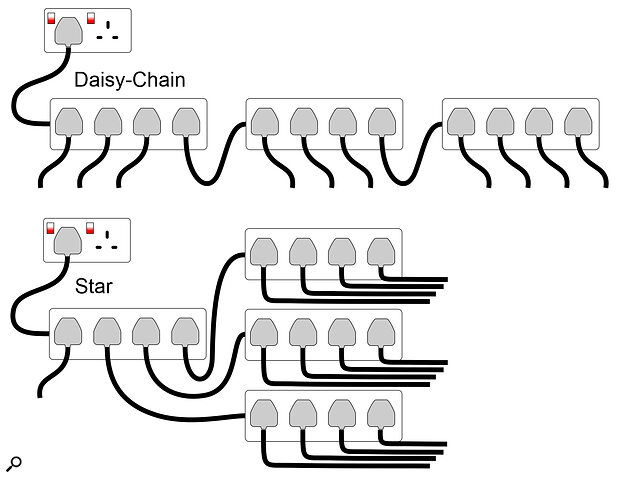 Arranging multiple plugboards in a star arrangement like this is less likely to result in ground‑loop problems than if you daisy-chain them.
Arranging multiple plugboards in a star arrangement like this is less likely to result in ground‑loop problems than if you daisy-chain them.
I’ve got a 19‑inch rack setup which currently houses six units (three effects, two preamps and an audio interface), and I’m wondering if it’s time that I considered powering it in a better way, especially as it might soon expand to include a few more units. Currently, everything is plugged into an extension cable which is daisy‑chained into another one. I know that this is less than ideal but it’s necessary given the limited number of mains sockets in my studio room.
I’ve read conflicting things about power conditioners; some say that they’re not at all necessary, but some people swear by them. I’m looking for some peace of mind regarding power surges, and a way to ensure that noise is kept to the minimum. Can you please offer some advice?
SOS Forum post
SOS Technical Editor Hugh Robjohns replies: It partly depends on the quality and stability of your mains supply. I’m based in the UK, where a power conditioner isn’t really necessary — though they remain popular as a convenient way of powering multiple units, and often have other handy features such as rack lighting! But if you’re in a country or location where there are frequent power outages, or if the supply voltage varies significantly (‘brownouts’), or if working in an industrial area where there are frequent spikes and transients on the mains, or the mains supply becomes heavily distorted (no longer sinusoidal), a proper power conditioning system can help. There are some good, effective designs available, but they are always expensive; the best option is often to use an uninterruptible power supply (UPS) which regenerates its own independent sinusoidal mains output — the so‑called online or ‘double conversion’ type.
Most affordable plugboards, mains distribution units and rack distribution units that claim to be ‘power conditioners’ are often of very limited use, and potentially could even makes things worse! Few can do anything to control the mains voltage to protect against brownouts, and although some do include filtering to improve a distorted mains supply, that can result in an increased ground impedance, which isn’t helpful. Most claim to provide protection against spikes, but the cheaper models rely on metal‑oxide varistors (MOVs) between phase/ground and neutral/ground, and these devices really aren’t very robust. After catching a few spikes they often don’t recover fully, resulting in an unbalanced current leakage to ground which can be sufficient to trip the mains supply’s RCD, particularly during switch on/off. Worse still, MOV failure has been blamed for causing fires, so avoid cheap ‘power conditioners’. If you’re concerned and want to protect sensitive equipment, I recommend investing in a high‑quality online UPS.
If you have multiple racks or other gear to power, run their plugboards back to another, in a star arrangement (as shown in the diagram) rather than daisy‑chaining them.
Personally, I generally just bolt a rack‑mounting mains distribution unit into the rear of the rack and power everything from that. You can get them with six or eight (13A) mains sockets. I use rackmount mains units made by Pulse, sold here in the UK through CPC (amongst others). The particular units I use have surge protection (not all do), you can use the switch to power the whole rack on/off if you want, and there’s also a removable cover to prevent accidental switching. There are other models with IEC outlets if you prefer those — they’re more compact and you’ll find strips with a greater number of sockets. I prefer to install the power board at the top rear of a rack, but if you have space it can go on the front; I’d put it near the bottom with space below to run the cables through. If you have multiple racks or other gear to power, run their plugboards back to another, in a star arrangement (as shown in the diagram) rather than daisy‑chaining them.
 In most cases, a rackmountable plugboard is probably all you need, and these can come with mains sockets (like the UK one pictured here) or more compact IEC sockets, and in various configurations for mounting at the front or rear of a 19-inch rack.
In most cases, a rackmountable plugboard is probably all you need, and these can come with mains sockets (like the UK one pictured here) or more compact IEC sockets, and in various configurations for mounting at the front or rear of a 19-inch rack.
Reviews Editor Matt Houghton adds: I’ve used a Samson Powerbrite ‘power conditioner’ in my setup for years but, as Hugh suggests, it’s mainly for the convenient features rather than the power conditioning: it has an on/off button on the front, where it’s easy to access; an always‑on ‘thru’ IEC socket on the front, which I use to hook up gear I’m testing or using temporarily; and a pop‑out light to illuminate the gear in the rack below. I also like that it uses the more compact IEC sockets instead of the bulkier UK mains ones. It’s worth noting that you can get power strips with both IEC sockets on the back and individual switches (one for each socket) on the front, which can be handy if you have gear in the rack that you only use from time to time. Pulse, for example, offer an eight‑way rackmount model for a very modest outlay, and if you search around you can find models with more room to add labels next to the switches and some with fuses for each socket that can be easily replaced from the front.
